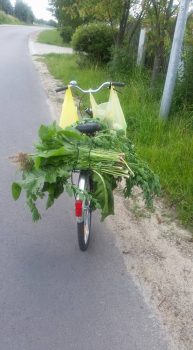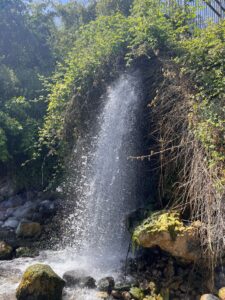When I had a chance to walk and bike through the country side, I took a better look at this plant and saw that it was not dock, but rather horseradish!
I dug up some horseradish root and used it for cooking, but mainly foraged the leaves. Being in the brassica/mustard family, the leaves smelled and tasted a little mustardy and sharp, but not nearly as spicy as the roots were. The leaves had a texture akin to kale (a close relative) and tasted like a cross between mustard leaves and kale, so I used them as a salad base together with….
Lambsquarters!
No, these lambsquarters weren’t photographed in Poland but at home. It looks like I forgot to photograph lambsquarters there. But they looked exactly the same as our local one and were growing everywhere too.
Plantain was growing all over as well. I saw two types- most of them were this rounded plantain, that I was familiar with from the US, but I saw a few with longer, thinner, pointier leaves, the same as we have locally.
I saw a lot of dock, though they weren’t the plants I originally saw in the middle of the night. I’m not exactly sure which species this is, maybe curly dock?
I also saw (but didn’t photograph) sheep sorrel.
Nettles grew all over the country side, and near it was a lot of deadnettle, which isn’t in the nettle family, has similar shaped leaves, but is actually in the mint family, with non stinging leaves and a square stem.
Speaking of the mint family, I saw creeping charlie or ground ivy for the first time that I know of. It’s also in the mint family, looks a lot like mallow or garlic mustard… I tasted it, didn’t particularly like it, so didn’t forage it.
I saw this other member of the mint family, square stem, leaves growing in pairs, flowers unique to the mint family, and even the leaves looked like peppermint, but it wasn’t spicy or minty at all, more bitter, so I don’t know which mint it is, but do know that it is edible.
One plant that I’ve been searching for for so long, ever since I learned about it, was pineappleweed. Its in the chamomile family and I saw it growing wild one time locally, about 4 years ago, in a tiny little patch. I found it one time at the farmer’s market…
I was pleasantly surprised to see it growing all over the countryside in Poland.
I brought home some, because… pineappleweed.
Dandelion was growing all over as well. I didn’t forage any, because it takes more work to make it palatable and I didn’t want to work hard to prep my food on vacation.
I saw daylillies which have edible flowers and other parts (not so sure which other parts since it doesn’t grow wild here), but I am not sure they were wild- they might have been cultivated.
I also saw lots of hollyhocks, again, not sure if wild or cultivated.
I foraged and ate a decent amount of chickweed, just straight out of the fields.
I saw sow thistle and lots and lots of wild lettuce, neither of which I foraged.
I saw a hawthorn tree…
There was lots of amaranth growing all over, just a different variety than what I usually see locally.
Turns out that this plant, which I saw all over, looked familiar, but not 100%, is mugwort, something I know my friend Pascale Bauder uses as the base for lots of his wild beers.
I saw large amounts of wild chicory.
I saw a decent amount of shepherds purse as well as some other types of wild mustard whose names I don’t know.
I thought I saw a sumac tree, but didn’t get a close look. But it turns out sumac does grow in Poland.
I saw lots of wild oats and clover. I saw white flowering yarrow plants. I saw cattails… which I would have loved to forage, but I was on a bus between cities when I saw them, so…
And last but not least…
Mallow….
Mallow might be one of the most commonly foraged plants all over the world, but I only spotted it on my last day in Poland.
I really found it fascinating how many of my local plants grow in Poland as well, how many plants grow all over the world. It actually gave me a very large boost of confidence, going to a country in which I’d never stepped foot in beforehand, and being able to identify so many different types of wild edible plants, because it made me realize that this skill that I have really is useful worldwide, and not just in my country or the US.
I actually tried to do some research about Polish edible wild plants before I arrived but didn’t find much information out there, so hopefully this post can be a resource for people traveling to Poland or the general area, or who live there, and want to forage.
Poland is perfect for foraging! At least in the summer… Come winter and it’s all covered in snow!
Which of the plants that I found in Poland do you have growing where you live? Have you foraged any of them?
If you’re a forager and have gone to a new country or new location far from home, what percentage of the plants that you saw there did you know?






















0 Responses
hi – I like your article, in my opinion, those plants exist all over europe, and are quite common…
hi – I like your article, in my opinion, those plants exist all over europe, and are quite common…
What a fabulous foraging day you had! By the way, when the dandelion greens come up early early in the spring they are much less bitter. I'm certain you already know that. Throughout the summertime, though, I steam some and mix it with eggs in the blender, with salt (1/2) teaspoon per egg, add unbleached flour and make green noodles. No bitterness ever detected. 🙂
What a fabulous foraging day you had! By the way, when the dandelion greens come up early early in the spring they are much less bitter. I'm certain you already know that. Throughout the summertime, though, I steam some and mix it with eggs in the blender, with salt (1/2) teaspoon per egg, add unbleached flour and make green noodles. No bitterness ever detected. 🙂
The Plant you thought was in the mint family but tasted bitter looks like prunella also know as 'heal all'. it's a common european plant and often found in gardens and lawns. not used for food but does has medicinal properties hence the nick name.
The Plant you thought was in the mint family but tasted bitter looks like prunella also know as 'heal all'. it's a common european plant and often found in gardens and lawns. not used for food but does has medicinal properties hence the nick name.
Love the article. Wish I had the confidence to forage. Afraid of killing someone. HaHa
Love the article. Wish I had the confidence to forage. Afraid of killing someone. HaHa
Fun! Yes, when I travel I enjoy seeing how many plants growing are similar to those where I live and what's new. Pinappleweed grew in the driveway at my farm! Burdock has edible roots but I've never eaten them; its everywhere in my locale. Glad you're enjoying the trip.
Fun! Yes, when I travel I enjoy seeing how many plants growing are similar to those where I live and what's new. Pinappleweed grew in the driveway at my farm! Burdock has edible roots but I've never eaten them; its everywhere in my locale. Glad you're enjoying the trip.
Glad your having a great time on your vacation.
Glad your having a great time on your vacation.
I'm already home, I'm just taking some time to finish writing up about it. Thank you!
I'm already home, I'm just taking some time to finish writing up about it. Thank you!
Awesome
Awesome
It's really not that scary! As long as you learn how to tell them apart from poisonous look alikes. Which isn't a big deal.
It's really not that scary! As long as you learn how to tell them apart from poisonous look alikes. Which isn't a big deal.
Thank you! I appreciate it. Always like to learn more.
Thank you! I appreciate it. Always like to learn more.
Great to know. What parts of europe are you familiar with?
I'll try that out. Thanks!
I'm glad you are writing up the Poland trip. I'm 1/2 Polish (American) and have been considering going to Poland one day.
I'm glad you are writing up the Poland trip. I'm 1/2 Polish (American) and have been considering going to Poland one day.